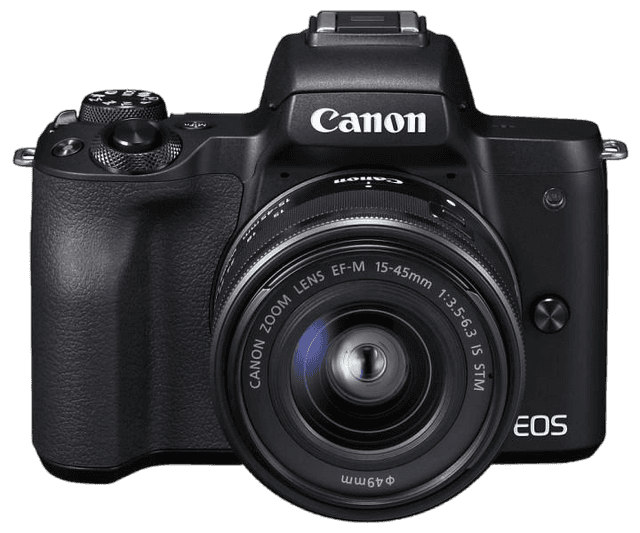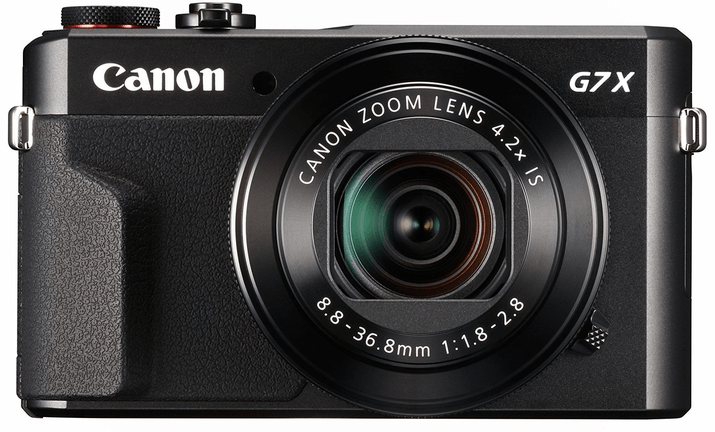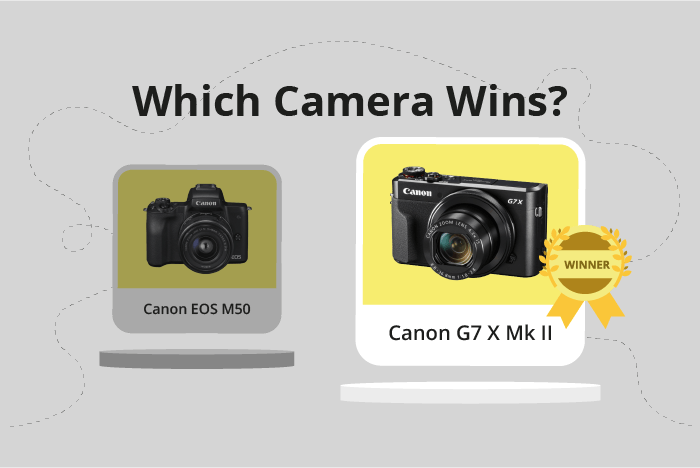Canon EOS M50 vs PowerShot G7 X Mark II Comparison
Canon EOS M50

Canon PowerShot G7 X Mark II

The Canon EOS M50 and the Canon PowerShot G7 X Mark II both have a score of 59/100, making it a tie in terms of overall performance. These two cameras share some similarities, such as being released in the same year and having similar launch prices. However, there are also some differences between them that set them apart.
The EOS M50, a mirrorless camera, is slightly larger and heavier than the compact PowerShot G7 X Mark II, measuring 116 x 88 x 59mm and weighing 390g. This size and weight difference can make the EOS M50 a better option for those who prefer a more substantial camera body for stability and grip.
On the other hand, the PowerShot G7 X Mark II is more compact, measuring 106 x 61 x 42mm and weighing only 319g. This makes it a great choice for those who value portability and want a lightweight camera that is easy to carry around.
Considering these factors, the Canon EOS M50 might be more suitable for users who prioritize sturdiness and grip, while the Canon PowerShot G7 X Mark II is a better option for those who prefer a lightweight and compact camera.
Canon EOS M50 vs PowerShot G7 X Mark II Overview and Optics
The Canon EOS M50 narrowly wins in the optics category with a score of 59/100, while the Canon PowerShot G7 X Mark II scores 58/100. Both cameras share some common specifications, such as the CMOS sensor type and the absence of image stabilization. However, there are key differences that set them apart.
The EOS M50 has a higher megapixel count at 24, compared to the G7 X Mark II’s 20 megapixels. This means the M50 can capture more detailed images. Additionally, the M50 has a faster shooting speed of 10 frames per second, as opposed to the G7 X Mark II’s 8 frames per second. This is beneficial for capturing fast-moving subjects. The M50 also boasts a larger APS-C sensor size, providing better image quality and low-light performance. Furthermore, the M50 has a Canon EF-M lens mount, allowing users to change lenses for different shooting scenarios.
On the other hand, the G7 X Mark II has a higher DXOMARK score for its sensor at 79, compared to the M50’s score of 58. This indicates better overall sensor performance. However, the G7 X Mark II uses a fixed lens mount, limiting users to the built-in lens.
To conclude, the Canon EOS M50 outperforms the G7 X Mark II in terms of megapixels, shooting speed, sensor size, and lens versatility. The G7 X Mark II’s advantage lies in its higher DXOMARK sensor score, though its fixed lens mount is a drawback. Ultimately, the choice between these cameras depends on the user’s priorities and shooting requirements, with the M50 offering more flexibility and the G7 X Mark II having a slightly better sensor performance.
Canon EOS M50 vs PowerShot G7 X Mark II Video Performance
The Canon EOS M50 outperforms the Canon PowerShot G7 X Mark II in video capabilities with a score of 91/100, while the latter scores 70/100. Both cameras share some common specs, such as built-in time-lapse functionality. However, there are significant differences in their video features that make the EOS M50 a better choice for video enthusiasts.
The EOS M50 offers a maximum video resolution of 4K, with dimensions of 3840 x 2160. This resolution allows for more detailed and sharper video quality. Additionally, the EOS M50 has a maximum video frame rate of 120fps, which is ideal for capturing smooth slow-motion footage. These features make the EOS M50 a more versatile and powerful camera for video recording.
On the other hand, the PowerShot G7 X Mark II has a maximum video resolution of Full HD and dimensions of 1920 x 1080. While this resolution is still suitable for casual video recording, it does not provide the same level of detail as 4K. The G7 X Mark II also has a lower maximum video frame rate of 60fps, which limits its slow-motion capabilities.
Despite these differences, the PowerShot G7 X Mark II is still a capable camera for video recording, especially for those who prioritize compactness and portability over advanced video features. Its Full HD resolution and 60fps frame rate are sufficient for most casual users.
Taking all of these factors into consideration, the Canon EOS M50 is the superior choice for video capabilities, offering 4K resolution and a higher frame rate. However, the Canon PowerShot G7 X Mark II still delivers decent video quality and may be a suitable option for those who prioritize size and simplicity.
Canon EOS M50 vs PowerShot G7 X Mark II Features and Benefits
The Canon EOS M50 and the Canon PowerShot G7 X Mark II both have a feature score of 70 out of 100. With identical scores, neither camera is a clear winner. They share several specifications, including a 3-inch screen size, 1040000-dot screen resolution, touchscreen functionality, flip screen capability, and the absence of GPS. Both cameras also come with WiFi and Bluetooth connectivity.
The EOS M50 excels in its interchangeable lens system, providing users with more flexibility and options for different shooting situations. This versatility allows for better image quality and creative possibilities. Additionally, the M50 has a larger sensor, which contributes to improved low-light performance and increased dynamic range. These factors make the EOS M50 a more suitable choice for those who demand higher image quality and adaptability.
On the other hand, the PowerShot G7 X Mark II offers a more compact and lightweight design, making it an ideal option for those who prioritize portability and convenience. It also features a faster lens, which can be beneficial in low-light situations and for achieving a shallower depth of field. The G7 X Mark II is a solid choice for casual photographers and travelers who prefer a camera that is easy to carry and use.
Taking these differences into account, the EOS M50 is the better option for those seeking versatility and improved image quality, while the PowerShot G7 X Mark II is more suited to those who prioritize portability and ease of use. Both cameras have their strengths and cater to different photography needs and preferences.
Canon EOS M50 vs PowerShot G7 X Mark II Storage and Battery
The Canon PowerShot G7 X Mark II outperforms the Canon EOS M50 in storage and battery, scoring 29 points against the M50’s 13 points. Both cameras share similarities in storage, having one memory card slot each and accepting SD, SDHC, and SDXC (UHS-I compatible) memory cards.
The G7 X Mark II takes the lead with a longer battery life of 265 shots compared to the M50’s 235 shots. Additionally, the G7 X Mark II possesses USB charging capabilities, making it more convenient for users on-the-go.
The EOS M50, however, does not surpass the G7 X Mark II in any specific aspect of storage and battery. As a result, the PowerShot G7 X Mark II proves to be the superior choice for users prioritizing storage and battery performance.
Canon EOS M50 vs PowerShot G7 X Mark II – Our Verdict
Are you still undecided about which camera is right for you? Have a look at these popular comparisons that feature the Canon EOS M50 or the Canon PowerShot G7 X Mark II:

